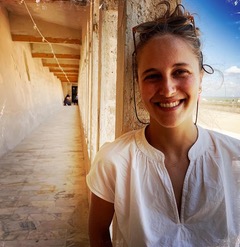A walk along the Via Emilia is a must to reach the beating heart of the region, Reggio Emilia: a city full of history and even more pleasantly walkable for the eighteenth edition of Fotografia Europea, which every year hosts exhibitions all over the city center, within iconic places such as the Cloisters of San Pietro, the Cloisters of San Domenico, Palazzo dei Musei or the Panizzi Library.

Camilla De Maffei. Grande Padre, Tirana, Albania, 2021 ©Camilla De Maffei, courtesy Fondazione Palazzo Magnani

Camilla De Maffei. Grande Padre, Tirana, Albania, 2021 ©Camilla De Maffei, courtesy Fondazione Palazzo Magnani
It is difficult to summarize in a few words what is barely visible in the space of an entire day, without running the risk of minimizing what is exposed, but it is believed that there is no such emblematic title as Visions of a restless identity to return a more general image. The complexity of the projects on display lies primarily in the narrative contents – collective stories of individuals critically related to their past and, even more, to the present: a combination exemplified by the ideal juxtaposition of projects such as Camilla de Maffei’s Grande Padre, Samuel Gratacap’s Bilateral or Simon Roberts’ Merrie Albion & The Brexit Lexicon. The photographers on display have used their medium as diary, if not as an archive. Today more than ever, this centenary form of art is turning to be an expedient to capture some events in a different light than the pre-established one: the absolute lens of a blind authority. Thus photography – anything but voyeuristic art or cold documentation of a past – is a different, accompanied, multiple and biographical gaze. Perhaps it becomes an image of voices that often have not been able to utter a word, giving the possibility of building an alternative memory, but not only; to make the viewer aware of the possibility of the existence of stories that almost never appear on our screens.

Alessia Rollo, Estasi nuziale, 2021, 100×80, ©Alessia Rollo, courtesy Fondazione Palazzo Magnani
This is the case of projects such as Parallel Eyes by Alessia Rollo, who evocates the invisible and imaginative scenario of the immaterial culture of Southern Italy through the technique of photographic manipulation; or Mónica de Miranda’s The Island, which deconstructs the patriarchal and phallocratic gaze of the colonial history of Portugal; or even The archive of public protest, a collective project of artist-activists that displays a real protest made of images; as Romanzo Meticcio by Davide Degano – one of the seven finalists of the Luigi Ghirri Prize 2023 – which narrates a story of marginalized gazes meditating on Italian identity and exclusion. It is not an easy challenge today to compete with the daily deafening jubilation of images. Precisely in this regard, Fotografia Europea is also a way to slow down and to get to know alternative trajectories of gazes: it is only by pausing that we then run the risk of being “caught” too. A peculiar path not only for the nature of the works on display, but also for the expository devices, where it will not be surprising to find extremely wide prints, photographs next to a plant, or reclined on the ground as if you could lie down on.

The archive of public protests, Women’s Strike Protest against nearly total abortion ban, Varsavia, 28.10.2020, courtesy Fondazione Palazzo Magnani
The museological complexity is realigned on the classic with A photographer’s life, the first major Italian retrospective that brings together the tireless work of Swiss photographer Sabine Weiss, who died in 2021. She photographed the lives at the edge of Europe, displaying a sort of journey back to the social Babel, restoring dignity and delicately recounting the human condition at the turn of the 1950s. The route could therefore be baptized by her shots, but the visitor will be free to move throughout the city – theater of photographs. Finally, the urban scenario is the protagonist of Un piede nell’Eden. Luigi Ghirri e altri sguardi: a current thought on the presence of green spaces within cities. Conversing with the Edenic photos is the concreteness of the drawings from the famous work L’Architettura degli alberi (1982): a gaze in the inner geography of these beings, whose architectural intelligence is usually sacrificed in favor of a real cultural overbuilding promoted by capitalist power.

Sabine Weiss. New York, USA, 1955 © Sabine Weiss, collections Photo Elysée, Lausanne, courtesy Fondazione Palazzo Magnani
Briefly, the festival proves to be a unique opportunity to meditate on some issues affecting our society, and consequently on the role that photography assumes in relation to its content. On the other hand, the comparison between the most current photography and that of the last decade lets questions of a formal and aesthetic nature arise. One wonders if the distorsion of certain shots, the precariousness of lines and perspectives, the risk of some compositional choices, are whether to be read in relation with the depth of the conveyed contents or as the manifesto of personal aesthetic interpretations, free from preset rules. The debate remains open: what is certain is that – as the photographer Joan Fontcuberta recently asserted – «if before photography was a document, today it is a biographical brand: we are in reality, this proves»[1].
Daria Ortolani
[1] Joan Fontcuberta about photography and truth, interviewed by Loredana Lipperini, Fahrenheit – Speciale in diretta dal Salone del Libro di Torino, 20/05/2023.
Info:
Fotografia Europea // XVIII
28/04/2023 – 11/06/2023
Reggio Emilia
https://www.fotografiaeuropea.it

Graduated in medieval art history at the Bologna Alma Mater Studiorum, she collaborates with the magazine by writing about contemporary art, with a careful eye on sculpture and photography.






NO COMMENT